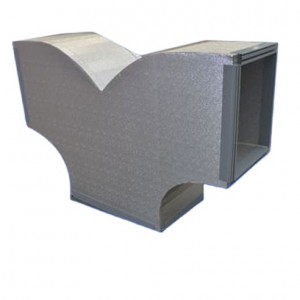
1. Phenolic air ducts are lightweight and can reduce building loads
The weight of phenolic composite air duct is light, about 1.4 kg/㎡, while the bulk density of galvanized steel sheet air duct (0.8mm thick) and fiberglass air duct (3mm thick) are 7.08 kg/㎡ and 15-20 kg/㎡, respectively. This can greatly reduce the load on the building and is extremely beneficial for the installation of air ducts. During installation, only one bracket needs to be installed every 4 meters to provide sufficient support. The bearing capacity requirements for brackets, suspension components, etc. are greatly reduced, making transportation and installation very convenient.
2. Phenolic formaldehyde composite air duct has good insulation properties, which can greatly reduce the heat dissipation loss of air conditioning
The thermal conductivity of phenolic composite air ducts is 0.020~0.025W/(m · k), while the thermal conductivity of galvanized steel sheet air ducts and fiberglass air ducts is much higher. In addition, the unique connection method of phenolic composite air ducts ensures excellent airtightness of the ventilation system, which is close to 8 times that of galvanized steel sheet air ducts. Some data show that when conveying the same heat (cold) amount, the heat loss of galvanized steel duct is 15%, that of glass fiber reinforced plastic duct is 8%, and that of phenolic foam insulation material duct is less than 2%.
The thermal conductivity of phenolic composite air ducts is low, while that of traditional air ducts is high. In addition, the unique connection method of phenolic composite air ducts ensures excellent airtightness of the ventilation system, and the heat loss is significantly lower than that of traditional air ducts.
3. Phenolic formaldehyde composite air duct is durable and has a long service life
Phenolic composite air ducts are not as prone to rust, aging, and damage as traditional air ducts, and their service life is at least 15 years or more. More than three times the service life of traditional air ducts. In addition, the reuse rate of phenolic composite air ducts can reach 60% to 80%, while traditional air ducts can hardly be reused.
4. Phenolic formaldehyde composite air duct has good sound insulation performance
The sandwich of phenolic composite air duct is made of porous phenolic foam material plate, which has good noise elimination performance. In the central air conditioning system, indoor noise can be significantly reduced. The phenolic composite air duct itself is a good pipe type muffler, and there is no need to install sound-absorbing accessories such as sound-absorbing covers or elbows.
5. Reduce floor height
Traditional air ducts require on-site insulation layer construction, therefore requiring a certain construction height, which puts additional requirements on the floor height of the building. Phenolic aluminum foil composite air ducts do not require on-site insulation construction, so there is no need to reserve construction space, which can reduce the height of the building.
6. Can shorten construction period
Phenolic composite air ducts are lightweight and easier to install than traditional air ducts. When hoisting air ducts, the required hangers are simple, with a small quantity and almost no need for machinery. The production is simple, completely breaking through traditional craftsmanship, greatly shortening the construction cycle, and on-site modifications are also very convenient. According to on-site calculations, during the installation of phenolic aluminum foil composite air ducts, each worker can install 20.0-30.0 square meters per day, while traditional air ducts only have 4.0-5.0 square meters per day per person. Compared with traditional air duct manufacturing, the production efficiency of phenolic aluminum foil composite air ducts has increased by 4-5 times.
7. Hygiene
The surface of the phenolic composite air duct is sealed with aluminum foil, ensuring the hygiene of the conveying medium, avoiding secondary pollution, and the inner layer is free of condensation and rust. In traditional air ducts, glass wool and asbestos are prone to moisture absorption, and their insulation performance deteriorates severely after absorbing water. Additionally, asbestos is a carcinogen, and glass wool dust can irritate the skin, causing construction workers to itch all over. In addition, galvanized steel sheet air ducts are prone to rusting and cold bridging.
8. Beautiful and suitable for surface decoration
Phenolic composite air ducts can be made in various colors, which are aesthetically pleasing and particularly suitable for surface installation. The surface of traditional air ducts requires on-site aluminum foil wrapping, so the surface installation effect is not very good.
9. Wide applicability
Galvanized steel sheet air ducts are widely used, but their service life is low in high humidity environments. The use of fiberglass air ducts in hospitals, food processing plants, basements, and other places with dust prevention requirements and high humidity is also limited. Phenolic composite air ducts can be widely used in industrial and civil buildings, hotels, hospitals, office buildings, and other places with special requirements.
10. Strong temperature adaptability
Phenolic composite air ducts are suitable for a wide temperature range and can be used under high and low temperature conditions (-190 ℃ to 120 ℃), unlike some other composite air ducts that can only be used at a temperature of 50 ℃.
Post time: Apr-08-2024
